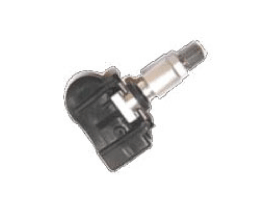Kia Cee'd: Tire Pressure Monitoring System / TPMS Sensor Description and operation

| 1. |
Function
| • |
By detecting the pressure, temperature, acceleration, and battery
condition, transmit information to ECU by a wireless RF.
|
| • |
Wheel location is recognized by comparing with Wheel Pulse of
ECS(ABS) and acceleration values of the sensor.(High Line)
|
|
| 2. |
Structure and features
| • |
It is consists of 4 that one for each wheel per vehicle is equipped.
|
| • |
Frequency change way is FSK, and High Line is used in common.
|
|
| 3. |
Mode
| • |
It is consists of the initial factory mode(EOL test mode}, the
stop and driving mode, and the automatic learning mode.
|
Features
|
Function
|
Valve Type
|
Clamp Type
|
Threaded length of the
valve cam
|
8.4mm
|
Material nut
|
AI6061[Baolong]
|
Seal
|
SR Seal
|
Battery Type
|
CR2450 Type
|
|
TPMS Automatic location Learning
| • |
Wheel angular velocity of each wheel is different when the two following
reasons:
|
| 1) |
Slip per each axis will occurs different.
|
| 2) |
Rotation radius(the radius of curve) per each wheel is different.
|
| 3) |
Tire wear, internal pressure, tire specifications, etc per tire are
different.
|
| • |
TPMS sensor is transmitred to RF signal at only specific phase(the angle
of the tire) in the learning mode.
|
| • |
TPMS receiver checks each tire phase(tire angle) information from when
receiving RF signals from the sensor.
|
| • |
RF signal of sensor ID 1,2,.3,4 is received every time, transmit to
ID of the most highly correlation among the phase of each collected
wheel.(RF signal reception every time, the phase of the tire is transmitted
to the constant wheel.)
|
| • |
TPMS sensor transmits the RF signal at intervals 16 seconds in the learning
mode.
|
| • |
After stop or parking more than 19 minutes, automatic learning for every
driving position is performed function.
|
| • |
The sensor is converted into Mode Parking when stopping or parking more
than 15 minutes, and Mode Parking is converted into Mode First Block
when detecting acceleration over 4g(15~20km/h).
|
Warning Lamp
| 1. |
Normal Mode
Function
| • |
Every IGN ON time, Cluster check TPMS Unit is available to communication
on the CAN line.
|
[Normal operation]
| • |
Cluster blinking for 3 seconds then off
|

[Wrong operation]
| • |
Cluster blinking for 1min then on.
|

|
| 2. |
Virgin mode
Function
| • |
TPMS is not learned sensor IDs
|
[Normal operation]
| • |
Cluster blinking for 3 seconds then off for 3second (repeat)
|
|
| 3. |
Low pressure lamp
Function
| • |
TPMS unit detect low pressure
|
[Normal operation]
| • |
There are no low pressure tire
|
[Low pressure lamp on operation]
| • |
There are low pressure tire
|
| • |
The tire pressure is below lamp on condition
|

|
| 4. |
Malfunction lamp
Function
| • |
TPMS unit detection system failure
|
[Normal operation]
| • |
There are no system failure
|
| – |
Cluster lamp off of TPMS
|

[Malfunction lamp on operation]
| • |
There are system failure
|
| – |
Cluster blinking for 1 min then on
|

|
TPMS sensors when replacing the precautions
| 1. |
TPMS sensors when replacing
| • |
Replaced the sensor should be stored in the ID of the receiver,
so the sensor KEY OFF before changing the receiver must wait
19 minutes after the super-vision mode as it enters the parking
location ID and learning can take place. After 25km / h or more
than 10 minutes driving to the vehicle speed and location ID
is saved automatically. Yeogeonsang difficult road, but the
actual storage, if necessary, rapid ID TPMS sensor by using
exciter's ID is entered directly. (High Line to the instructions
in the case of diagnostic equipment shall comply with the location
of the tire.)
|
|
| 2. |
Tire exchange position
| • |
Has changed the location of the sensor on the receiver should
be recognized. Pressure sensors are also located, as is the
case with the exchange before the exchange is waiting more than
19 minutes after the KEY OFF 25km / h or more, driving more
than 10 minutes are saved automatically when you changed the
location. In practice, however, difficult to ride fast exciter
TPMS ID is stored, if necessary, using the sensor's ID is entered
directly. (High Line to the instructions in the case of diagnostic
equipment shall comply with the location of the tire.)
|
|
| 3. |
Receiver exchange position
: Diagnostic Equipment (TPMS exciter included) will conduct the following
tasks.
| (1) |
Vehicles must enter the code.
|
| (2) |
Enter the VIN number.
|
| (3) |
Makes the sensor ID to enter.
|
| (4) |
IG ON IG OFF after 10 seconds is.
("TPMS" to determine whether the lamp lit)
|
|
TPMS Inspection method
Inspection
Find the inspection number by referring to the table above.
...
Removal
1.
Remove the valve core and deflate the tire.
2.
Remove the side of the tire bead area from the wheel using tire changing
...

 Troubleshooting
Troubleshooting TPMS Sensor Repair procedures
TPMS Sensor Repair procedures



